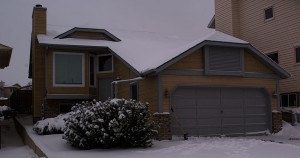I was watching an episode of Holmes Inspection and Mike Holmes had a very easy and quick way to check on the insulation and heat loss in your roof in the winter.
Go outside the morning after a heavy snow fall. The snow fall has to be sufficient to leave snow on the roofs in your neighbourhood for this test to work. Have a look at the roofs in your area to see how much snow is on the roof.
If you see that you have had more snow melt off your roof than your neighbours then it is probably a safe bet that you have increased heat loss through your roof. This could be because of a lack of insulation, insufficient ventilation, or any other number of causes. Whatever the case, it is something that you should investigate if you want to increase the efficiency of your heating and decrease the amount of heat that you are loosing through your roof.
To view the snow depth on the above photo I had to turn up the contrast and turn down the brightness, thus making the image vary dark. Based on that photo from last winter I would say that I have minimal heat loss through the roof as I believe the only place that the snow is shallow on our roof was caused by the wind. Thankfully there appears to be no significant heat loss through the roof.
I’m going to have another look at this after our first significant snow fall this upcoming winter and will post the results and photos on this site. I will also put some photos of other houses where you can see the heat loss by the melted snow on their roofs so you can see what I’m talking about.

Great idea. It doesn’t snow much round here, but heat loss through the roof is such a waste of money. Good insulation can reduce energy bills a huge amount for sure.
I noticed last year that many houses where I live were leaching heat from their roofs through poor installation of insulation or none at all- observing as you have outlined when it has snowed. It is a cheap to remedy with loft insulation and easy to do – and no I do not sell loft insulation , but this winter maybe I should !